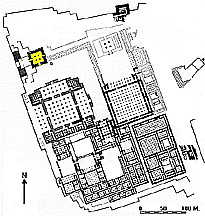The Gate of Xerxes

To the north of the Apadana stands the impressive Gate of Xerxes, from which a broad stairway descends. Xerxes, who built this structure, named it “The Gate of All Countries,” for all visitors had to pass through this, the only entrance to the terrace, on their way to the Throne Hall to pay homage to the king. The building consisted of one spacious room whose roof was supported by four stone columns with bell-shaped bases. Parallel to the inner walls of this room ran a stone bench, interrupted at the doorways. The exterior walls of the structure, made of thick mud brick, were decorated with numerous niches. Each of the three walls, on the east, west, and south, had a very large stone doorway. A pair of colossal bulls guarded the western entrance; two assyrianized man-bulls stood at the eastern doorway. Engraved above each of the four colossi is a trilingual inscription attesting to Xerxes having built and completed the gate. The doorway on the south, opening toward the Apadana, is the widest of the three. Pivoting devices found on the inner corners of all the doors indicate that they must have had two-leaved doors, which were probably made of wood and covered with sheets of ornamented metal.
- Gate of Xerxes, Guardian Bulls of W Doorway, with Top Landing of Terrace Stairs, P 202
- Gate of Xerxes, General View with Water Tank in Center Foreground, P 1174
- Gate of Xerxes, Guardian Man-Bulls of E Doorway, P 60784
- Gate of Xerxes, Guardian Man-Bull and Inscription on N Jamb of E Doorway, P 124
- Gate of Xerxes, NE Column Base, P 1184
- Gate of Xerxes, Unit of a Fallen Capital Lying Inverted in NE Corner, P 58204

